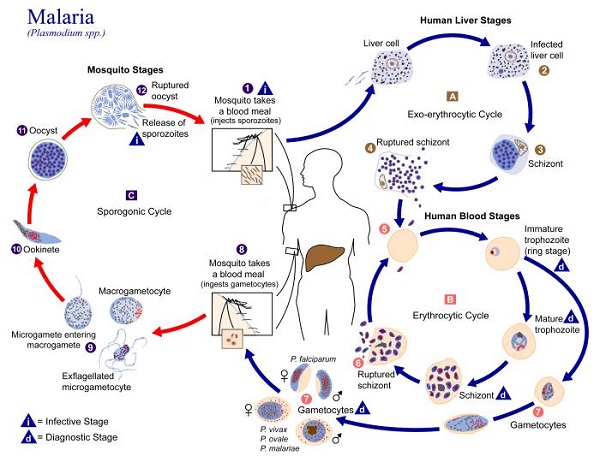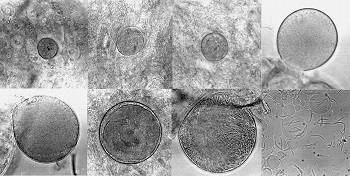Plasmodium malariae - Life Cycle
Life Cycle of Plasmodium malariae
These parasites show an alternation of generation accompanied by an alternation of hosts. In the human host, the asexual cycle (schizogony) takes place inside the erythrocytes while the sexual cycle (sporogony) takes place in the female Anopheline mosquito.
Plasmodium malariae has a similar life cycle to P. falciparum. Relapse does not occur due to the absence of the hypnozoite stage while subsequent attacks are caused due to the persistence of a small number of erythrocytic forms in the internal organs.

Figure: P. malariae life cycle (Source: CDC)
Human Cycle
A bite by a female Anopheles mosquito during the blood meal injects the Plasmodium malariae sporozoites into the capillaries of the skin
these parasitic sporozoites enter the blood circulation and within less than 30 minutes, they enter the host liver tissue cells
Exo-erythrocytic schizogony
the Plasmodium malariae sporozoites are covered with circumsporozoite protein which facilitates the invasion of host liver cells and not other host tissues
the circumsporozoite protein binds specifically and non-covalently with receptors present hepatocyte cell membrane’s basolateral area
these sporozoites undergo asexual reproduction called pre-erythrocytic or primary exo-erythrocytic (PE) schizogony which transforms sporozoites into trophozoites
these trophozoites mature after a few days by feeding on host cell cytoplasm and the disappearance of organelles of the apical complex
multinucleate liver-stage schizonts (PE schizonts) are developed with the formation of numerous daughter nuclei in trophozoites
mature schizonts are multinucleate, spherical, and measure more than 55μm and each contains 15,000 uninucleate merozoites
Finally, mature PE schizonts and enlarged liver cells rupture, releasing thousands of merozoites into the host bloodstream
primary exo-erythrocytic schizogony takes place in Plasmodium malariae and is completed in 13 to 18 days
unlike in P. vivax and P. ovale, there is no secondary exo-erythrocytic schizogony and no formation of hypnozoites and there is no true relapse
Plasmodium malariae merozoites after entering the RBC never invade the liver and thus exo-erythrocytic forms are always absent in blood-induced malaria such as during blood transfusion
Although there is no true relapse of P. malariae infection, recrudescence of the disease may occur 1-3 years after remission of the disease
the recrudescence occurs due to the persistence of a small number of merozoites in the infected host RBC
prolonged, chronic, low-grade asymptomatic infection may exist
Erythrocytic schizogony
the merozoites released from liver cells into the blood attach and invades the old RBC but rarely reticulocytes are infected by Plasmodium malariae merozoites
the invasion occurs via the apical ends of trophozoites when the major surface glycoprotein and other sialoproteins attach to the RBC membrane
the merozoites transform into young trophozoites or ring forms and feed on hemoglobin by consuming RBC cytoplasm
as an end, metabolic product, a malaria pigment and a compound of haematin and ferric acid called hemozoin are produced
the trophozoites undergo mitosis followed by division of the cytoplasm to form mature schizonts
each mature schizont contains 8-12 merozoites as well as hemozoin which eventually rupture merozoites into the blood circulation
these schizonts infect new RBCs within seconds and the cycle of schizogony reappears
in Plasmodium malariae erythrocytic schizogony takes place inside capillaries and vascular beds of internal organs (not peripheral blood) and completes in 72 hours
after several erythrocytic cycles, some merozoites develop into gametocytes
these gametocytes mature in the internal organs after which they appear in the blood

Image: Development of oocysts of Plasmodium malariae in Anopheles freeborni mosquitoes. Top row, 10-, 11-, 12-, and 13-day oocysts; bottom row, 14-, 15-, and 17-day oocysts and sporozoites (Source: journals.asm.org)
Mosquito cycle
The sporogony or sexual life cycle of Plasmodium malariae takes place in the female Anopheles mosquito.
Sporogony
both the macrogametocytes and microgametocytes are ingested by the female Anopheles mosquito during a blood meal from infected humans
after reaching the mid-gut (stomach) of the mosquito, the male gametocyte (microgametocyte) undergoes exflagellation, which is the transformation by rapid division
* exflagellation involves microgametocytes becoming extra cellular followed by repeated division of the nucleus within 10-12 minutes to form 6-8 daughter nuclei
* eventually, each nuclei becomes surrounded by a developing axoneme
* finally, the microgametocyte rupture to release 6-8 daughter nuclei- with each nuclei containing an axoneme bud which later becomes microgametes
these microgametes are highly motile sperm-like organisms with a single flagella
the female gametocyte (macrogametocyte) matures by a single process of nuclear reduction and extension of polar bodies
each macrogametocyte can only give rise to only one macrogamete
the male gametocyte nucleus fuses with the female gametocyte nucleus through the process of fertilization and a zygote is produced
the zygote is formed within 20 to 120 minutes from the blood meal by the vector mosquito
the zygote then lengthens and extends to form a motile ookinete which is more slender in P. vivax than in other Plasmodium spp
this ookinete penetrates the gut wall of the mosquito host, secrets a thin wall, and grows into a sphere which is termed an oocyst
the oocyst contains a number of sporoblasts (haploid nucleated masses) and matures in 13 days
these sporoblasts then divide repeatedly to form sporozoites which are in turn released into the hemocoel of the mosquito after rupturing of oocyst – the process called sporogony
the Plasmodium malariae sporozoites, which are infectious to humans, migrate to the salivary glands
sporozoites are injected into the human host when the mosquito takes a blood meal from a healthy human and the life cycle of Plasmodium malariae is continued